St KATHARINE DOCK.
| Initial planning for St Katharine Dock began in 1823. The site chosen had originally been occupied by the St Katharine's Hospital and the church attached to it called St Katharine's By The Tower. The hospital had been established by Queen Matilda, the wife of King Stephen, in 1148. The church was finally pulled down in 1825 to make room for the dock. The dock preserved the name of both the hospital and the church as can be seen by the bollards used for mooring the ships. The Royal Foundation of St Katharine still survives not far away in Butcher Row in Ratcliffe, just off Commercial Road. For more on St Katharine see Bollard. The warehouses round this dock were built close to the water, so that freight could be unloaded by cranes straight from the ship into the warehouse. This cut down the risk of pilfering, and so the dock was used for valuable cargoes like ivory, spices and marble, etc. When the docks were built 11,000 residents were forced to quit their homes, but only the landlords were compensated. The soil excavated to make the docks was shipped upstream and put into marshy areas to provide firm foundations for what is now Pimlico and Belgravia. (This latter operation may have an unintentional hidden symbolism.) |
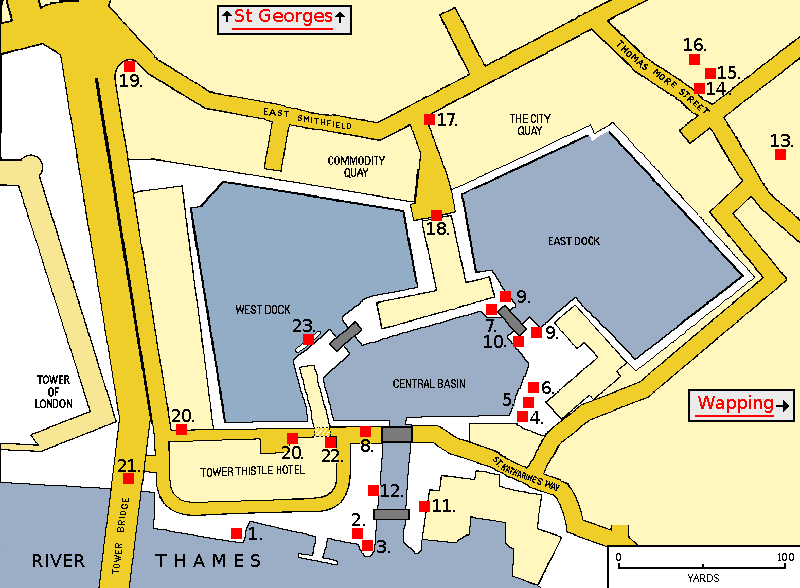 | CONTENTS | |
| 10. Anchor | ||
| 15. "Angelic Musician" | ||
| 19. Art In The Underpass | ||
| 12. Bollard | ||
| 3. Cannon | ||
| 7. "Echoed Aromas" | ||
| 17.Elephants | ||
| 20.Enamel Panels | ||
| 5. "Exotic Birds" | ||
| 9. Telford's Footbridge | ||
| 16. "Geese." | ||
| 1. "Girl With a Dolphin." | ||
| 8. "Here The Sea Shells." | ||
| 22. Hydraulic Hoist | ||
| 6. "To The Sea" | ||
| 23. "Lightship X" | ||
| 14. Sir Thomas More | ||
| 2. "Timepiece." | ||
| 13. "To Meet Again." | ||
| 21. Tower Bridge | ||
| 11. William III | ||
PUT MOUSE OVER  TO READ NAME
TO READ NAME
CLICK ON  FOR PHOTO & EXPLANATION.
FOR PHOTO & EXPLANATION.
 |
Anchor. | |
From a Dutch merchant ship called the "Amsterdam." Which sank off Hastings, c. 1800. (See No. 10.. on Map) |
||
 |
"Angelic Musician." | |
Thomas More Square. The figure is placed on top of a pole presumably implying that his place of residence is up above. Fortunately, he is not accompanied by piped music, either heavenly or otherwise. (See No. 15. on Map) Sculptor: Carl Milles. 1991. |
||
 |
Art in The Underpass. | |
In the underpass under East Smithfield there is a permanent display of 90 works by the children of four Schools. These were Snowfields Primary School, Tower Bridge School, Hermitage School and Cat Santos Shapla School. These schools were assisted by professional artists: Julia Budd, Alison Rabjohns, Mark Cazalet, Susan Goldblat and Sonia Martin. This was part of the One Mile East Public Art Project in 1998. The theme of the entries is the Tower of London and its history. The illustration shows King Henry VIII. (See No. 19. on Map) Artist: Bilkis Begum. |
||
 |
Bollard. | |
Saint Katharine's Dock. One of many still on the dock which were originally used for mooring ships. The top of the bollard has written on it "ST. KATHARINE BY THE TOWER" arranged around the edge. In the centre is a human figure dressed in a long robe, wearing a crown, and holding a sword uplifted. As the figure appears to have a halo and as there is a wheel beside it, this must be St Katharine who was martyred on a wheel. By the side of the saint there is the central keep of the Tower. The story of Katherine is that she was the daughter of a King ruling Alexandria. She converted to Christianity and when Emperor Maximinus ordered her to sacrifice to his gods, she refused. For this she was sentenced to death by being broken on a wheel. This story gave rise to the naming of the fireworks known as Catherine Wheels. (This paragraph deliberately reflects the lack of uniformity in the spelling of the name.) The regular repainting of the bollards for weather protection has tended to obscure the original design. (See No. 12. on Map) (There are many of these bollards around the dock, so this is not the only position where it can be found.) |
||
 |
Cannon. | |
This stands guarding the Thames entrance to St Katharine Dock. It is a 36-pounder and is probably French in origin. It has been said of it that it had a high muzzle velocity but a low accuracy. Originally, it would probably have had a wooden mounting resting on wheels. The gun and mounting would have been secured by ropes, so that after firing the recoil could be controlled and thus preventing injury to the crew. (See No. 3. on Map) Date: Early 18th century. |
||
 |
Elephants. | |
One of a pair of elephants surmounting the gateposts to the entrance to St Katharine Docks, in East Smithfield. Ivory was one of the most important commodities unloaded in these docks. This explains the name of Ivory House which is still standing by this dock. (For the elephants, see No. 17. and for Ivory House see No. 18. on Map) Artist: Peter Drew. 1973. |
||
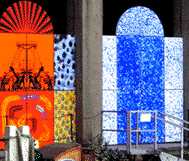 |
Enamel Panels |
|
In Cloisters Walk, St Katharine Dock. A series of panels in vitreous enamel on the theme of the activities of the dock in past years. The panels were prepared with the help of pupils from St Paul's Way Community School, Stepney and St Saviour's and St Olave's School Southwark. (See No. 20. on Map) Artist: Dale Devereux Barker. 1998. |
||
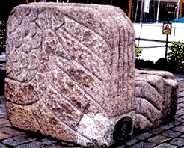 |
"Exotic Birds" and Other Sculptures | |
St. Katharine's Dock. One of seven sculptures by the same artist, which have as their theme, the merchandise which used to be unloaded at this dock. The stones used for these sculptures were part of the original dock. The sculptures are:
Sculptress: Paula Haughney. Series 1997- 1999. (By the same Sculptress see also "Dockers' Memories", "Heron", "Lord Mayor's Dragon", "The Passenger", "Ram and Magpie", and "Smiling Beast") |
||
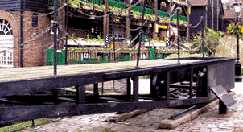 |
Telford's Footbridge. | |
St. Katharine's Dock. This footbridge used to span the entrance to the East Dock. The earliest plans for the bridge were signed by Thomas Rhodes, Thomas Telford's senior engineer. When large ships wanted to enter the dock, the two halves had to be withdrawn. This was possible because they were mounted on wheels which ran on railway track. This bridge remained in situ until 1994. The two sections are as near to their original site as is practical. (See No. 9. on Map) Designer: Thomas Rhodes. 1829.
| ||
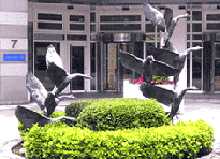 |
"Geese." | |
Thomas More Square, in front of Gemini Court. Sculpture showing a number of geese taking off in flight. The sculptor David Norris was born in Brazil and studied at the Royal Accademy Schools, London. (See No. 16. on Map) Sculptor: David Norris. 1990.
| ||
 |
"Girl With a Dolphin." | |
Statue and fountain placed outside the Thistle Tower Hotel in the shadow of Tower Bridge. David Wynne, born 1926, is noted for his animal sculptures and the depiction of movement. This sculpture gives the illusion of the figures flying unsupported. (See No. 1. on Map) Sculptor: David Wynne. 1973. |
||
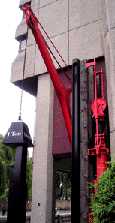 |
Hydraulic Hoist. | |
On the corner of Thistle Tower Hotel, facing Central Basin. These hoists were fixed to the walls of warehouses and used to load and unload lighters and barges. In this exhibit the vertical beam represents the wall of the warehouse so the piston and system of pulleys (known as jiggers) were inside. Hydraulic Power was introduced to replace steam engines which were a fire hazard. Due to the pulleys, a movement of the piston of four inches resulted in lifting a load 32 inches. Many of these hoists can still be seen on the old warehouses around the Docklands. If you are standing looking at this exhibit, turn round and you will see one on the side of Ivory House. (See No. 22. on Map.)For other uses of hydraulic power see Tower Bridge and Shadwell Bridge |
||
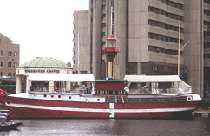 |
"Lightship X." | |
Permanently moored in West Dock. This ship was built in Copenhagen in 1877 and served as a lightship there for many years. After the Nazi invasion, the Germans moved it in 1943 to a position south of Anholt Knob. It was opened as a floating restaurant in 2002. If you visit the restaurant below decks, you will see the old timbers which form the hull. (See No. 22. on Map) | ||
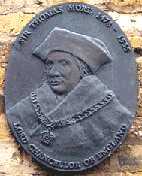 |
Sir Thomas More. | |
In Thomas More Street, on the gateposts of the entry leading to Thomas More Square. Sir Thomas More (1478-1535) after whom the street and square are named, served with distinction in a number of posts under Henry VII and Henry VIII. He was Speaker of the House of Commons, Chancellor to Duchy of Lancaster and, against his better judgment, became Lord Chancellor. After the break with Rome, his religious beliefs prevented him from accepting Henry VIII as head of the Church of England. For this he was imprisoned in the Tower and eventually beheaded. Thomas More Street was formerly Nightingale Lane, which got it's name from Knighten Guild (various spellings) that owned this land. The Guild sold the land to the Augustinians who built the original St Katharine's Hospital. (See No. 14. on Map) Sculptor: (?) Date (?) | ||
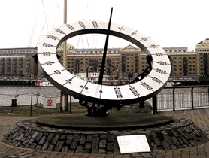 |
"Timepiece." | |
Situated on the bank of the Thames outside the Thistle Tower Hotel. The work has reminders of the dock's past. The chains which support it are reminiscent of anchor chains. The ring of the sundial is a giant washer. The central gnomen is an enlarged nail. The artist originally had a workshop at St Katharines Dock but now works in Bow in Tower Hamlets. (See No. 2. on Map) Designer: Wendy Taylor. 1973. (See also Docklands Enterprise, Knowledge, Rope Circle and Voyage 2001 by the same artist.)
|
||
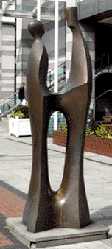 |
"To Meet Again." | |
Thomas More Square. The sculpture shows a tender reunion. (See No. 13. on Map) Sculptor: Michael Beck. 1990. |
||
 |
Tower Bridge. | |
This famous bridge, completed in 1894, has been used as an icon for London just as the Eiffel Tower symbolizes Paris. In the 19th century the Thames upstream of the Tower was still being used for unloading cargos from ocean-going vessels. So when a road bridge was planned here, provision had to be made for high-masted ships to pass. The two main towers are made of steel girders. For appearances, these girders have been hidden behind stone surfacing of Portland stone and Cornish granite. The bridge was designed to harmonize with the nearby Tower of London. Up till 1911 the two walkways on the upper level were open to the public, who had to walk up stairways in the towers to reach them. But they were closed because few people bothered to climb 200 foot and down again. Particularly as the two halves of the bridge each weighing 1200 tons could be raised and lowered in the space of five minutes. On the south bank there is a building which houses two tall "accumulators" which provides the water pressure for the Hydraulic Power to raise and lower the roadway sections. The bridge is still raised by hydraulic power however, the pumps which generate the water pressure are no longer driven by steam engines. Since 1976 they have been driven by electricity and oil. (See No. 21. on Map) |
||
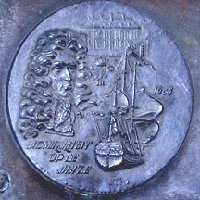 |
King William III. | |
On the wall of the Dockmaster's house, beside the lock at the entrance to St Katharine Dock.. This plaque was fixed in 1988 in the presence of Queen Beatrix of the Netherlands to commemorate three centuries of Anglo-Dutch naval friendship. 1688 was the year of the "Glorious Revolution" when the Protestant William of Orange arrived in England with his wife Mary to displace the unpopular Catholic James II, and so became King and Queen. This brought the two Protestant countries closer together. (See No. 11. on Map) Sculptor: Willem Verbon. Date; 1988. |
||
OTHER AREAS COVERED:-
|| Beckton || Bethnal Green || Blackwall || Bow || Bromley-by-Bow || Canary Wharf || Canning Town || Chingford || Cubit Town || Custom House || East Ham || East India Dock || Forest Gate || Higham's Park || Leyton || Leytonstone || Limehouse || Little Ilford || Manor Park || Mile End || Millwall || North Woolwich || Plaistow || Plashet || Poplar || St George's || Shadwell || Shoreditch || Silvertown || Snaresbrook || Spitalfields || Stepney || Stratford || Upton || Walthamstow East || Walthamstow Village || Walthamstow West || Wanstead || Wapping || West India Dock || Whitechapel || Woodford || |
 www.britainexpress.com/bio/telford.htm
www.britainexpress.com/bio/telford.htm